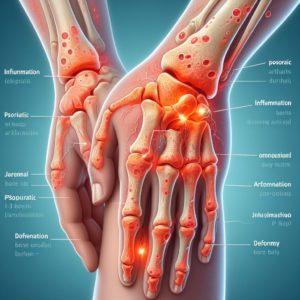Psoriatic arthritis: When Psoriasis becomes Psoriasis arthritis.
Psoriatic arthritis is a chronic form of information of the joints that affects some people who have psoriasis. 10% of patients with psoriasis have joint involvement.
The disease often appears age between ages 30 and 50. It begins about ten years after psoriasis develops for many people, but some develop psoriatic arthritis first or without recognising psoriasis.
It’s not curable, but there is a growing range of treatments available to prevent disease advancement, lessen pain, protect joints and preserve a range of motion. It is essential to work with a rheumatologist (a doctor specialising in the immune system joints, bone and muscles) to find the right treatments.
Psoriatic arthritis symptoms can develop slowly, with mild symptoms, or it can develop quickly and severely. Some people may develop psoriatic arthritis in a joint after a trauma or injury. Development may also associate with genetics.
What Are The Symptoms?
- Fatigue
- pain and swelling over tendons.
- Swollen fingers and toes
- Stiffness, tenderness in one or more joints
- Decreased range of motion
- Morning stiffness and fatigue
- Nail changes like pitting or separation from the nail bed
- Redness and pain of the eye (uveitis)
Diagnosis
Classification of psoriatic arthritis
The Classification Criteria for Psoriatic Arthritis consist of common inflammatory articular disease with at least 3 points from the following features:
• Current psoriasis (2)
• History of psoriasis the absence of current psoriasis (1)
• A family history of psoriasis -in the lack of current and previous history of psoriasis; ( 1)
• Dactylitis ( 1)
• Juxta-articular new-bone formation ( 1)
• RF negativity (1)
• Nail dystrophy ( 1)
Laboratory findings
No particular diagnostic tests are available for psoriatic arthritis. The abnormalities in patients with the situation follow:
• Elevations of the erythrocyte sedimentation rate (ESR)
Elevation of C-reactive protein (CRP).
•Negative rheumatoid factor in 91-95% of patients
•In 10-20% of patients with generalised skin disease, the serum uric acid concentration may increase
•Low levels of circulating immune complexes detected in some patients
•Serum immunoglobulin A levels are increased in two-thirds of sufferers.
•Synovial fluid is inflammatory, with cell counts and with more than 50% of cells being polymorphonuclear leukocytes.
Radiological changes:
The following radiographic abnormalities can see in psoriatic arthritis:
joint space narrowing in the interphalangeal joints, possibly with ankylosis.
Increase joint space in the interphalangeal joints due to destruction.
Fluffy periostitis
Bilateral, asymmetrical, fusiform soft-tissue swelling
Unilateral or symmetrical sacroiliitis.
Magnetic resonance imaging:
Sensitive for detecting sacroiliitic synovitis, enthesitis, and erosion.
May demonstrate inflammation in the hands’ small joints.
How Can We Treat?
Medical treatment includes nonsteroidal anti-inflammatory drugs (NSAIDs), Janus kinase (JAK) inhibitors, and disease-modifying antirheumatic drugs (DMARDs).
DMARDs include:
• Methotrexate
• Sulfasalazine
• Cyclosporine
• Leflunomide
Biologic agents, TNF, PDE4, or interleukin inhibitors)
In patients with severe skin inflammation, medications; methotrexate, retinoic-acid derivatives, psoralen, and ultraviolet (UV) light should consider.
These agents work on the skin and joint manifestations. Intra-articular injection for single inflamed joints with corticosteroids may be beneficial for some patients. Use DMARDs in individuals whose arthritis is never-ending.
Surgical care
An arthroscopic synovectomy is useful in chronic, monoarticular synovitis.
Joint replacement or reconstructive therapy is sometimes necessary.
Patients in severe pain or significant contractures may refer for possible surgical intervention; however, high recurrence rates of joint contractures distinguished after surgical release, especially in hand.
The arthrodesis and arthroplasty performed on joints, for instance, in the thumb’s proximal – interphalangeal joint.
The wrist often spontaneously fuses, this may reduce the patient’s pain without surgical intervention
For arthritis mutilans, surgical intervention directed toward salvage of the hand; combinations of arthrodesis, arthroplasty, and bone grafts to lengthen the digits may use.
Physical therapy
The rehabilitation treatment program for psoriatic arthritis patients should be individualised and start in the disease’s initial stage. Such a plan should consider the use of the following:
•Rest
•Exercise: Passive, active, stretching, strengthening, and stability
•Modalities: Heat, cold
•Orthotics: Upper and lower extremities, spinal column.
• Possible improvements to homes and automobiles.
•Education about the disease, energy preservation techniques, and joint protection methods.
•Possible vocational readjustments
Early recognition of the disease and treatment of psoriatic arthritis can prevent or limit the extensive joint involvement and damage in later stages of the disease.




